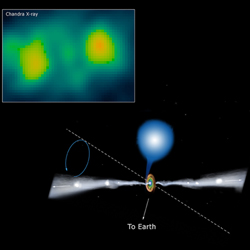December 10, 2002
RELEASE: 02-11
Lobes of unexpectedly hot gas speeding away from a black hole in our galaxy have been discovered by NASA's Chandra X-ray Observatory. The high temperature and the distance of the lobes from the black hole indicate that violent collisions are occurring between clumps of gas expelled from the vicinity of the black hole.
"Just like a super highway, it's a dangerous world out there," said Simone Migliari on the University of Amsterdam, lead author on a paper from a September 6, 2002 issue of Science magazine. "Blobs of gas are getting rear-ended at speeds in excess of a hundred million miles per hours!"
The team of scientists from the University of Amsterdam and the National Institute for Space Research (SRON) in Utrecht, The Netherlands, observed the source SS433, a binary star system in our galaxy that consists of a black hole and a massive star. They detected two lobes of hot gas with temperatures of 50 million degrees that are 0.25 light years on either side of the black hole system. A key finding was evidence indicating rapidly moving hot iron atoms.
The energies of the X-rays from the iron atoms in the two clouds were shifted by the Doppler effect - the same process that causes the frequency of an ambulance's siren to shift up and down as the ambulance approaches and recedes. By measuring this shift, they concluded that the lobes move away from the vicinity of the black hole in opposite directions at a quarter of the speed of light. The observations indicate that one lobe is moving along a line tilted toward Earth whereas the other one is moving along a line tilted away from Earth.
The detection of the hot gas lobes some distance away from the central black hole was a surprise. Earlier observations by Chandra and the Hubble Space Telescope had shown that gas was cooling as it expanded away from the black hole. This led scientists to predict that no hot gas would be found further than a few million kilometers from the black hole.
"These new observations prove that the expansion cooling model doesn't work," said Rob Fender of the University of Amsterdam, and a coauthor on the paper. "The gas must get reheated, most likely by high-velocity blobs smashing into lower speed ones."
This model is also supported by long-term optical monitoring observations that indicate that matter is ejected every few minutes in bullet-like gaseous blobs from the vicinity of the black hole. The bullets would travel outward for several months without colliding until a faster bullet runs into a slower one, precipitating a pileup that reheats the gas. Future Chandra observations will test this model.
The team, which also included Mariano Mendez of SRON, observed SS 433 with the Advanced CCD Imaging Spectrometer on June 27, 2000, for a period of 9,600 seconds. ACIS was built for NASA by Penn State, University Park, and the Massachusetts Institute of Technology, Cambridge, Mass. NASA's Marshall Space Flight Center, Huntsville, Ala., manages the Chandra program for the Office of Space Science in Washington. TRW, Inc., Redondo Beach, Calif., is the prime contractor for the spacecraft. The Smithsonian's Chandra X-ray Center controls science and flight operations from Cambridge, Mass.
MEDIA CONTACTS
Steve Roy
Marshall Space Flight Center, Huntsville, AL
Phone: 256-544-6535
Megan Watzke
Chandra X-ray Observatory Center, CfA, Cambridge, MA
Phone: 617-496-7998
cxcpress@cfa.harvard.edu



